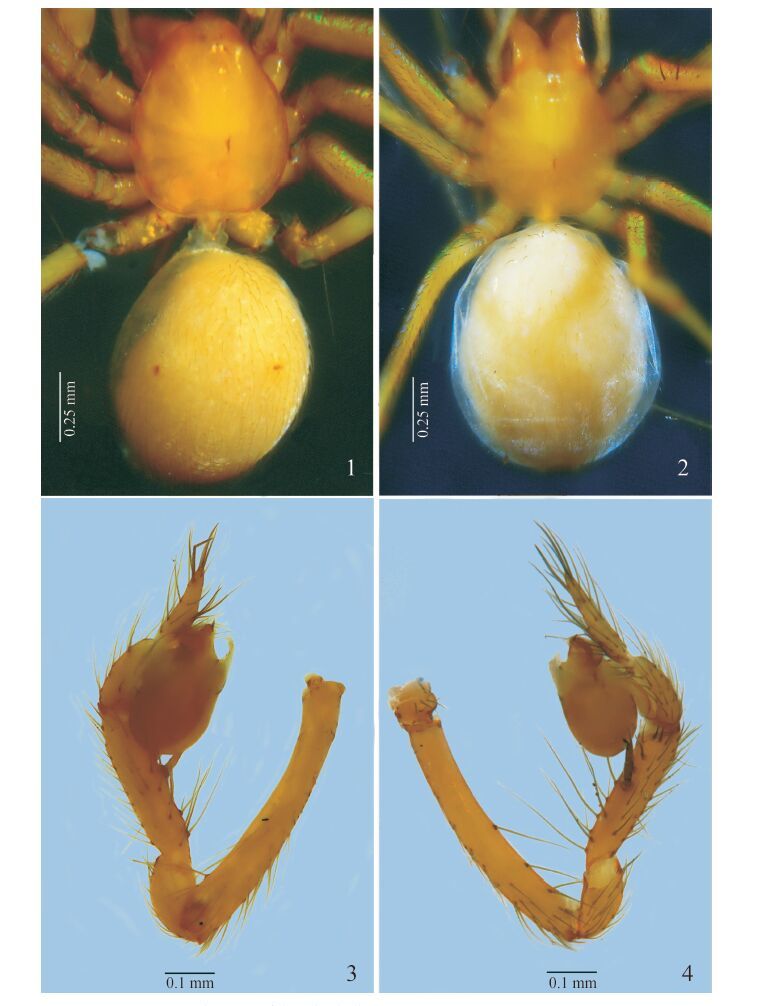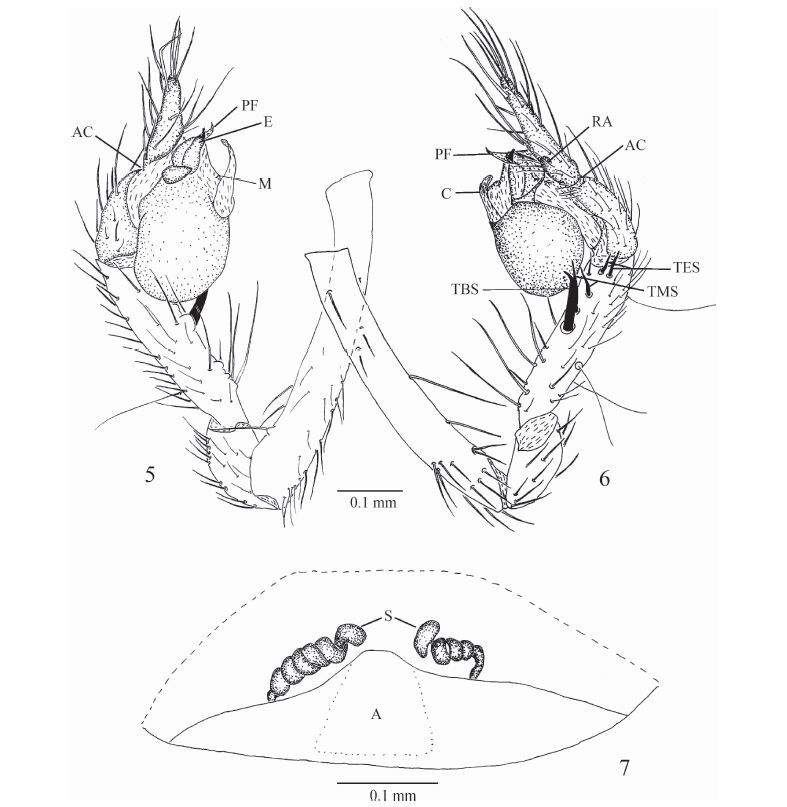扩展功能
文章信息
- 郭轩, 余志刚, 陈会明
- GUO Xuan, YU Zhigang, CHEN Huiming
- 贵州洞穴小弱蛛属一新种记述(蜘蛛目:弱蛛科)
- One New Spider Species of Genus Leptonetela (Araneae: Leptonetidae) from Cave in Guizhou, China
- 四川动物, 2016, 35(3): 395-399
- Sichuan Journal of Zoology, 2016, 35(3): 395-399
- 10.11984/j.issn.1000-7083.20150274
-
文章历史
- 收稿日期: 2015-09-09
- 接受日期: 2015-11-21
小弱蛛属Leptonetela由Josef Kratochvíl于1978年建立,目前已知有50种(World SpiderCatalog,2015),主要分布于中国(贵州、江西、浙江、安徽、湖南、广西、重庆)、格鲁吉亚、希腊、土耳其、越南(Deeleman-Reinhold,1971;Brignoli,1976,1979;徐亚君,宋大祥,1983;陈樟福等,1984;Deltshev,1985;Dunin,1990;Gasparo,2005;陈会明,朱明生,2008;Chen et al.,2010;Lin & Li,2010; Wang &Li,2011),其中分布于贵州的种类最多,有31种。
作者在鉴定采自贵州省的弱蛛科标本时,发现小弱蛛属一新种,将其命名为施秉小弱蛛Leptonetela shibingensis sp. nov.。本文测量单位均为mm。模式标本保存于贵州科学院生物研究所。 施秉小弱蛛Leptonetela shibingensis sp. nov. (图版Ⅰ,图版Ⅱ)

|
| 图版 Ⅰ 施秉小弱蛛,新种Leptonetela shibingensis sp. nov. Plate Ⅰ Leptonetela shibingensis sp. nov. 1. 雄蛛,背面观 Male body,dorsal view; 2. 雌蛛,背面观 Female body,dorsal view; 3. 雄蛛左触肢器,内侧面观 Left male palp,prolateral view; 4. 雄蛛左触肢器,外侧面观 Left male palp,retrolateral view. |
| |

|
| 图版 Ⅱ 施秉小弱蛛,新种Leptonetela shibingensis sp. nov. Plate Ⅱ Leptonetela shibingensis sp. nov. 5. 雄蛛左触肢器,内侧面观 Left male palp,prolateral view; 6. 雄蛛左触肢器,外侧面观 Left male palp,retrolateral view; 7. 雌蛛外雌器,背面观Female genitalia,dorsal view; A. 中庭atrium,AC. 雄蛛触肢顶缩apical constriction of male palp,C.引导器conductor,E. 插入器embolus,M. 中突median apophysis,PF. 顶片proapical flange,RA. 跗节后侧突 retrolated tarsal apophysis,S. 纳精囊spermathecae,TES. 雄蛛触肢胫节末刺endmost spine of male palpal tibia,TBS. 雄蛛触肢胫节基刺basal spine of male palpal tibia,TMS. 雄蛛触肢胫节中刺median spine of male palpal tibia. |
| |
正模♂,贵州省施秉县白朵乡石家湾村穿洞上洞(27°10.544'N,108°11.802'E,海拔671 m),2012年11月3日,陈会明、郭轩采。副模:4♂♂,3♀♀,采集信息同正模;4♂♂,10♀♀,贵州省施秉县白朵乡石家湾村坳田洞(27°10.189'N,108°11.697'E,海拔1 097 m),2012年11月4日,陈会明、郭轩采;1♂,5♀♀,贵州省施秉县牛大场镇喇叭筒塘坎洞(27°12.495'N,108°01.884'E,海拔1051 m),2012年7月19日,陈会明、郭轩采。 郭轩等:贵州洞穴小弱蛛属一新种记述(蜘蛛目:弱蛛科)
词源学:新种种名源自模式标本采集地施秉县的汉语拼音,"shibing" 加上拉丁化后缀"ensis"。
鉴别特征:区别于其他种的特征是,插入器顶部具1小锥体,基刺短粗且末端突然变细并向内强烈弯曲。本新种近似于查氏小弱蛛L. zhai Wang & Li,2011(Page 88~90,Figs 69~71),主要区别有:眼退化,仅留眼丘(图版Ⅰ:1~2),后者6眼完全;雄蛛触肢器中突小,三角形(图版Ⅱ:5),而后者中突大,近掌状;雄蛛触肢器胫节基刺短而粗,末端向内弯曲(图版Ⅰ:4,图版Ⅱ:6)。
描述:正模(图版Ⅰ:1),雄蛛,体形似雌蛛,腹部侧面观较雌蛛扁平。体长1.65。背甲光滑,淡黄色,长0.68,宽0.56,厚度为宽度的0.84倍;中窝褐色,针状。额黄色。螯肢长0.37,淡黄色,前齿堤8齿,后齿堤6小齿;基部具8根短刚毛。眼退化,仅留4个眼丘,眼域两侧具2根刚毛。胸板长0.46,宽0.43,具毛。下唇长0.08,宽0.12,淡黄色。腹部乳黄色,无斑纹,具毛,长0.85,宽0.68。
步足淡黄色,胫节Ⅰ、Ⅱ具曲毛;后跗节Ⅱ和Ⅲ具栉器。步足测量(腿节+膝节+胫节+后跗节+跗节=总长)Ⅰ:1.74+0.24+1.86+1.48+0.96=6.28;Ⅱ:1.50+0.23+1.52+1.19+0.80=5.24;Ⅲ:1.30+0.23+1.24+1.04+0.66=4.47;Ⅳ:1.61+
0.22+1.59+1.34+0.85=5.61。步足式:1423。
触肢基节长0.35,宽0.16。触肢测量(腿节+膝节+胫节+跗节=总长):0.49+0.15+0.26+0.34=1.24;触肢胫节长度为膝节长度的1.73倍。触肢胫节背面具3根听毛(图版Ⅱ:6);腹面具5根刺,2根末刺、2根中刺、1根基刺,基刺末端向内弯曲(图版Ⅱ:6);前侧面具几根细长刺。跗节末端收缩,中部的顶缩较浅;后侧突位于后侧面,靠近顶端;跗节后侧面具一排短刚毛在后侧突上和跗节的基部;跗节顶端具多根长刚毛(图版 Ⅰ:3~4;图版 Ⅱ:6)。生殖球近卵圆形,前侧突卵圆形;中突小三角形(图版 Ⅱ:5);顶片细条形(图版 Ⅰ:3~4;图版 Ⅱ:5~6)。
副模,雌蛛,体形似雄蛛,腹部侧面观较雄蛛高。体长1.42。背甲光滑,长0.56,宽0.46,厚度为背甲宽度的0.74倍,淡黄色;中窝褐色,针状(图版Ⅰ:2)。额淡黄色。螯肢长0.34,淡黄色,前齿堤6齿和1小齿,后齿堤6小齿;基部具8根短刚毛。完全退化,仅留6个眼丘,眼域后具2根刚毛(图版Ⅰ:2)。胸板长0.45,宽0.33,具毛。下唇0.06长,0.13宽,淡黄色。腹部乳黄色,无斑纹,具毛,长0.82,宽0.68。外雌器为宽阔的三角形,简单;内面观具1对盘旋的纳精囊,具1三角形的中庭(图版Ⅱ:7)。
步足淡黄色;后跗节Ⅱ和Ⅲ具梳器。步足测量(腿节+膝节+胫节+后跗节+跗节=总长):Ⅰ:1.71+0.25+1.85+1.38+0.96=6.15;Ⅱ:1.42+0.25+1.42+0.99+0.36=4.44;Ⅲ:1.29+0.27+1.21+0.96+0.71=4.44;Ⅳ:
1.62+0.21+1.57+1.31+0.84=5.55。足式1423。触肢基节长0.29,宽0.13。触肢测量(腿节+膝节+胫节+跗节=总长):0.45+0.15+0.35+0.44=1.39。
分布:目前仅知分布于模式标本的采集地。
| 陈会明, 朱明生. 2008. 贵州织金洞真洞穴蜘蛛一新属一新种(蜘蛛目Araneae:弱蛛科Leptonetidae)[J]. 大理学院学报, 7 (12):11–14. |
| 陈樟福, 沈永昶, 高枫. 1984. 浙江岩洞弱蛛属二新种记述(蜘蛛目:弱蛛科)[J]. 杭州师院学报(自然科学版, (1):18–13. |
| 徐亚君, 宋大祥. 1983. 我国弱蛛一新种(蜘蛛目:弱蛛科)[J]. 徽州师专学报(理科版), (2):24–27. |
| Brignoli PM. 1976. Ragni di Grecia IX[J]. Specie nuove o interessanti delle famiglie Leptonetidae, Dysderidae, Pholcidae ed Agelenidae (Araneae)[J]. Revue Suisse de Zoologie : 539–578. |
| Brignoli PM. 1979. Spiders from Turkey, VI[J]. Four new species from the coast of the Black Sea (Araneae)[J]. Bulletin of the British Arachnological Society : 310–313. |
| Chen HM, Jia Q, Wang SJ. 2010. A revision of the genus Qianleptoneta (Araneae:Leptonetidae)[J]. Journal of Natural History : 2873–2915. |
| Deeleman-Reinhold CL. 1971. A new species of Sulcia Kratochvil (Araneida, Leptonetidae) from Greece, and a discussion of some Japanese cavernicolous Leptonetidae[J]. Zoologische Mededelingen : 289–301. |
| Deltshev CD. 1985. New data concerning cave spiders (Araneae) in Greece with description of a new Leptonetela (Araeae, Leptonetidae)[J]. Acta Zoologica Bulgarica : 41–45. |
| Dunin PM. 1990. Leptonetela caucasica sp[J]. n.-a first finding of spiders of the family Leptonetidae (Aranei, Haplogynae) in the USSR[J]. Zoologicheskiǐ Zhurnal, 69 (1): 147–149. |
| Gasparo F. 2005. Una nuova Leptonetela cavernicola di Grecia (Araneae, Leptonetidae)[J]. Bollettino del Museo Regionale di Scienze Naturali di Torino : 517–524. |
| Lin YC, Li SQ. 2010. Leptonetid spiders from caves of the Yunnan-Guizhou plateau, China (Araneae:Leptonetidae)[J]. Zootaxa : 1–93. |
| Wang CX, Li SQ. 2011. A further study on the species of the spider genus Leptonetela (Araneae Leptonetidae)[J]. Zootaxa : 1–90. |
| World Spider Catalog. 2015. Natural history museum bern[EB/OL].[2015-08-31]. http://wsc.nmbe.ch, version 16.5. |
 2016, Vol. 35
2016, Vol. 35




